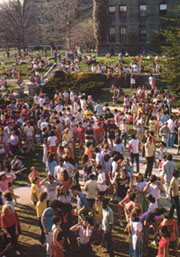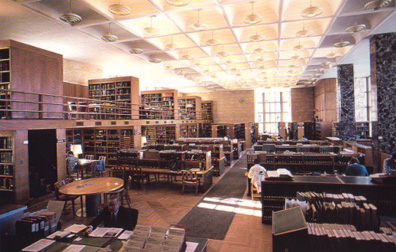|
● Going
to School in America Today
● Education—A Local Matter
● What
an American Student Learns
● Education
in a New Nation
● Learning
to Be World Citizens
● Higher Education
● Selecting
a College or University
● Trends in Degree Programs
● Education for All
Higher Education
 |
|
University Students
|
 Out
of more than three million students who graduate from high school
each year, about one million go on for higher education. Simply
by being admitted into one of the most respected universities in
the United States, a high school graduate achieves a degree of success.
A college at a leading university might receive applications from
2% of these high school graduates, and then accept only one out
of every ten who apply12. Successful applicants at such colleges
are usually chosen on the basis of: (a) their high school records;
(b) recommendations from their high school teachers; (c)
the impression they make during interviews at the university; and
(d) their scores on the Scholastic Aptitude Tests (SATs). Out
of more than three million students who graduate from high school
each year, about one million go on for higher education. Simply
by being admitted into one of the most respected universities in
the United States, a high school graduate achieves a degree of success.
A college at a leading university might receive applications from
2% of these high school graduates, and then accept only one out
of every ten who apply12. Successful applicants at such colleges
are usually chosen on the basis of: (a) their high school records;
(b) recommendations from their high school teachers; (c)
the impression they make during interviews at the university; and
(d) their scores on the Scholastic Aptitude Tests (SATs).
 The
system of higher education in the United States is complex. It comprises
four categories
of institutions:(1) the university, which may contain: (a) several
colleges for undergraduate students seeking a bachelor's
(four year) degree and (b) one or more graduate schools
for those continuing in specialized studies beyond the bachelor's
degree to obtain a master's
or a doctoral
degree; (2) the four-year undergraduate institution—the
college—most of which are not part of a university; (3) the technical
training institution, at which high school graduates may take courses
ranging
from six months to four years in duration and
learn a wide variety of technical skills, from hair
styling through business
accounting to computer
programming; and (4) the two-year, or community
college, from which students may enter many professions
or may transfer
to four-year colleges or universities. The
system of higher education in the United States is complex. It comprises
four categories
of institutions:(1) the university, which may contain: (a) several
colleges for undergraduate students seeking a bachelor's
(four year) degree and (b) one or more graduate schools
for those continuing in specialized studies beyond the bachelor's
degree to obtain a master's
or a doctoral
degree; (2) the four-year undergraduate institution—the
college—most of which are not part of a university; (3) the technical
training institution, at which high school graduates may take courses
ranging
from six months to four years in duration and
learn a wide variety of technical skills, from hair
styling through business
accounting to computer
programming; and (4) the two-year, or community
college, from which students may enter many professions
or may transfer
to four-year colleges or universities.
 Any
of these institutions, in any category, might be either public or
private, depending on the source of its funding. There is no clear
or inevitable distinction in terms of quality of education offered
between the institutions which are publicly or privately funded.
However, this is not to say that all institutions enjoy equal prestige
nor that there are no material differences among them. Any
of these institutions, in any category, might be either public or
private, depending on the source of its funding. There is no clear
or inevitable distinction in terms of quality of education offered
between the institutions which are publicly or privately funded.
However, this is not to say that all institutions enjoy equal prestige
nor that there are no material differences among them.
 Many
universities and colleges, both public and private, have gained
reputations for offering particularly challenging courses and for
providing their students with a higher quality of education. The
great majority are generally regarded as quite satisfactory. A few
other institutions, conversely, provide only adequate education,
and students attend classes, pass examinations and graduate as merely
competent, but not outstanding, scholars and professionals. The
factors determine whether an institution is one of the best or one
of lower prestige are quality of teaching faculty, Many
universities and colleges, both public and private, have gained
reputations for offering particularly challenging courses and for
providing their students with a higher quality of education. The
great majority are generally regarded as quite satisfactory. A few
other institutions, conversely, provide only adequate education,
and students attend classes, pass examinations and graduate as merely
competent, but not outstanding, scholars and professionals. The
factors determine whether an institution is one of the best or one
of lower prestige are quality of teaching faculty,
 |
| Faculty
Members |
 |
A
University Library |
quality of research facilities; amount
of funding available for libraries, special programs, etc.; and
the competence and number of applicants for admission, i.e., how
selective the institution can be in choosing its students. All
of these factors reinforce one another.
 In
the United States it is generally recognized that there are more
and less desirable institutions in which to study and from which
to graduate. The more desirable institutions are generally—but
not always more costly to attend, and having graduated from one
of them may bring distinct advantages as the individual seeks employment
opportunities and social
mobility within the society. Competition to get into
such a college prompts
a million secondary school students to take the SATs every year.
But recently emphasis on admissions examinations has been widely
criticized in the United States because the examinations tend to
measure only competence in mathematics and English. In defense of
using the examinations as criteria for admissions, administrators
at many universities say that the SATs provide a fair way for deciding
whom to admit when they have 10 or 12 applicants for every first-year
student seat. In
the United States it is generally recognized that there are more
and less desirable institutions in which to study and from which
to graduate. The more desirable institutions are generally—but
not always more costly to attend, and having graduated from one
of them may bring distinct advantages as the individual seeks employment
opportunities and social
mobility within the society. Competition to get into
such a college prompts
a million secondary school students to take the SATs every year.
But recently emphasis on admissions examinations has been widely
criticized in the United States because the examinations tend to
measure only competence in mathematics and English. In defense of
using the examinations as criteria for admissions, administrators
at many universities say that the SATs provide a fair way for deciding
whom to admit when they have 10 or 12 applicants for every first-year
student seat.
Previous Page Next
Page
|

